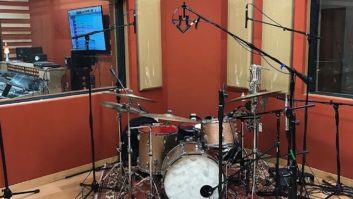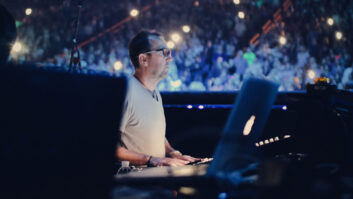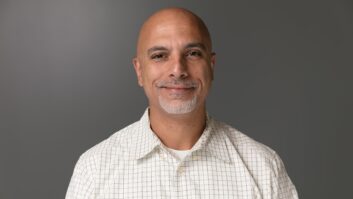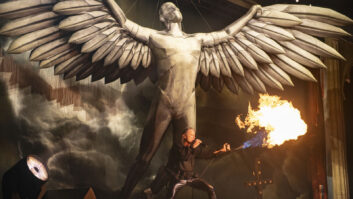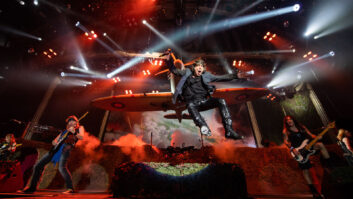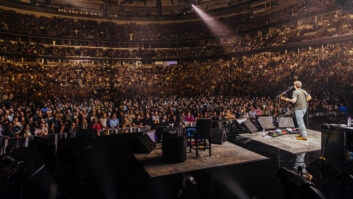Los Angeles, CA—Four-time Grammy Award-winning UK singer-songwriter Sam Smith’s second studio album, The Thrill of It All, debuted at the top of the UK and U.S. charts in November 2017 and launched a tour that is scheduled to run through April 2019. The production design is unusual, with a stage that is essentially just a thrust that extends 107 feet into the audience, requiring an equally unusual sound design configuration to meet the challenges it presents.
Rehearsals took place in a hotel ballroom in Lake Como, Switzerland, says veteran front-of-house engineer Jim Ebdon, whose résumé includes Maroon 5, Matchbox Twenty and Aerosmith, among others. “We really got the mix dialed in nicely and got everything sitting right,” he says.
For this tour, Ebdon selected an L200 desk from Solid State Logic, a brand he’s been using for a couple of years. “They sound like an analog console with a save button. I like the ergonomics of the layout,” he says of features such as the faders being in a single row and its accommodation of a display screen to each side.

“I think they have a character on the mix bus,” he adds, which was important for the project, which promotes an album recorded largely to 16-track by Irish producer and engineer Stephen Fitzmaurice. “He’s a big fan of really good quality mics and old outboard gear, so I thought, that’s how I’m going to approach this,” Ebdon says.
The show is all about Smith’s voice, of course. “We tried a few mic capsules and few different compressor choices and ended up with the Sennheiser 5235 capsule” mounted on an SKM 5200-II transmitter, a combination that the four backing singers also use, Ebdon reports. Mic choices for the five stage musicians were equally judicious and include various AKG, Heil, Neumann, Royer, Sennheiser and Shure models, together with Avalon U5 and Radial JDI and J48 direct boxes.
Smith’s vocal travels via a Neve 1073 DPA preamp at the stage before Ebdon sends it through a Tube-Tech CL 1B compressor. “You might look at it and think it’s over-compressing, but when that needle is slamming over on the left, it just sounds fantastic,” he says.
He manages Smith’s potent high-mid range with a Sonnox Oxford EQ plug-in and applies UA’s Tube-Tech CL 1B re-creations to the background vocals. Vintage AMS and EMT reverb plug-ins supplement a pair of Bricasti hardware reverb boxes. The plug-ins are hosted on a Soundcraft Realtime Rack, with a Waves SoundGrid server handling plug-in effects such as flanging and ADT.

“I live under the stage like a troll, as once pointed out by a friend of mine,” says monitor engineer Saul Skoutarides, who chose a DiGiCo SD7 for the tour. In addition to managing about 80 inputs from stage, which split to monitors and FOH via a rack of Midas DL431 interfaces, he controls a “shout mic” system of approximately two-dozen channels. “Because none of us can see each other,” he says.
Skoutarides picked the SD7, he says, “because I need the functionality of the automation. And I can build macros to do whatever I want.”
Using the SD7’s macros, he enables the MD and band members to talk among themselves or to Smith in various combinations, and for the techs to converse among themselves. “No matter what shout mic gets talked into, the crew always hear them, so we can back each other up,” he says.
Skoutarides has two four-engine TC Electronic System 6000 reverbs available and puts a Crane Song STC-8 analog bus compressor across Smith’s mix. Everyone uses Sennheiser 2000 Series wireless ears with JH Audio earbuds—Roxanne custom models, in the case of the performers and Skoutarides. The tour’s RF tech, George Hogan, handles the unusually long stage configuration using his custom antenna management system.
Skoutarides’ secret weapon is a Cedar DNS8 Live box, originally designed to suppress noise between lavalier mics for broadcast. “It allows me to filter room reverb out of the microphones. You can teach it what you don’t want in the mics, then you can dial in how much of that processing you want.”
System tech Liam Halpin rose to the challenges presented by the long, narrow stage and the production design—twin IMAG screens, circular rear-projection screen, lighting trusses and “The Shard,” a 50-foot high, three-sided projection screen construction—with a design that encompasses as many as 80 d&b audiotechnik J8 and 32 V8 line array modules, plus 24 J-Subs, in six blocks of four, all flown. Four J-Infra triple-21-inch subs below the stage—two pointing forward and one to each side—supplement the flown rig. A full 22 compact T10 two-way boxes, mounted to the sides of the 5-foot-high stage on custom hanging shelves, provide audience fill.
https://www.instagram.com/p/Bm1MTqBhC5f
There are 34 d&b D80 amplifiers per side, housed in custom carts to fit beneath the stage, says Halpin. Signal cabling and power distribution are similarly customized for quick load-in and deployment. Amp signal distribution is via a redundant Dante network and d&b DS10 network bridges, with overall EQ processing by Lake LM44s. There is a high level of redundancy throughout, from the consoles (the second desks also being available to opening acts) to the networking, which has an AES backup.
Capital Sound, based in London and newly integrated into the SSE Group, provided the sound equipment. Every component of the tour production was shipped by container from the UK and will go on to Australia while the tour picks up local production for its Southeast Asia shows.
The tour’s sound design was driven by the need to extend coverage to the front rows of seats that run along both sides of the stage and up to its front tip, Halpin explains. “If you want to cover the front row, you have to put a hang in line with the side of the stage. That also means you’ve got to point the bottom box down.”
Halpin spent three months of full-time work on the design, he reports, inputting the CAD drawings and his own precise measurements of representative venues such as London’s O2 Arena and Manchester Arena into d&b’s ArrayCalc simulation software. He often spends hours pre-show at each venue adding measurements to improve the accuracy of the available drawings. “The consistency we’ve had from show to show has more than justified the effort.”
To provide the necessary coverage, he continues, “We ended up with a lot more cabinets than you would normally carry on an arena tour. Each J8 hang is 20 boxes deep. The last box aims 80 degrees down.”
The two front and two side J8 arrays must be carefully aligned with each other. “The bottom box of the side hang acts as a fill underneath the main hang,” he says. “And Sam spends a lot of time on the tip of the stage, so I can’t hit that too hard.”
Indeed, the acoustic center is near the downstage lift that brings Smith to the stage, from which Halpin must cover roughly 310 degrees. Viewed as a traditional end stage, the production sells each venue’s seats to 270 degrees.
Providing that coverage means there’s up to 16 boxes for each V8 hang. Halpin explains, “Quite often I’m using 10 boxes even if there’s a wall. The floor seating extends to the Shard, so I need that many boxes to achieve the down-tilt to get the coverage.” The d&b ArrayProcessing software manages the wall proximity, he adds.
“Rather than trying to pick a single point to align the system, I’m looking at the overall low-end response throughout the whole venue. It allows me to get the best average response for the greatest amount of the audience,” he adds.
The array weight is close to the load limit of the rigging system, says Halpin. Because balcony seating extends higher at many U.S. venues, “we’re shooting up with the hangs, which allows me to shift more of the weight onto the front motor. For some of the lower audience profiles, I’ve put three or four boxes on top of the hang to act as a counterweight. It’s a constant battle between what makes acoustic sense and mechanical sense.”
The stage configuration means that there is no wide stereo spread, Ebdon notes. Consequently, the production’s FOH position is off to one side of the floor. Pro Tools playback of additional elements and the keyboards is stereo, he adds, “but none of the drums are panned; they’re all straight up the middle.”
The off-center FOH position necessitated by this tour’s sound design has been an education, says Ebdon. “The interesting thing is you don’t get a power alley, which is fantastic.”
In a standard production, where Ebdon is centrally located, he and maybe 10 percent of the audience experience that power alley. “I’d rather concentrate on the 90 percent,” he says. “If I end up doing a regular end-on, left/right gig next year, I’m going to mix off to the side.”
Capital Sound • www.capital-sound.co.uk
d&b audiotechnik • www.dbaudio.com
